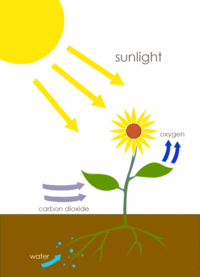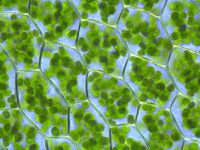Photosynthesis
Start a vegetable garden - Lesson 4: Photosynthesis
- Topic in Gardening courses
Photosynthesis is the process by which green plants and some other organisms use sunlight to synthesize foods from carbon dioxide and water. It is the magical process that makes all our gardening and farming worthwhile. Air (carbondioxide) and water and sunlight are transformed into energy (sugar) and the structural element (carbon) for cells and oxygen to breathe.
Photosynthesis is vital for all life on Earth that needs oxygen.
- Photosynthesis maintains normal levels of oxygen in the atmosphere
- It is the source of energy for building up the cells of an organism in which photosynthesis occurs, or as a source of food, it gives this energy to other organisms. For example, humans and animals eat plants.
The exception are some organisms such as bacteria that live in hostile environments such as deep sea vents.[1]
Chemical reaction of photosynthesis
- Carbon dioxide (chemical formula CO2) is a naturally occurring chemical compound composed of two oxygen atoms covalently bonded to a single carbon atom. It is a gas at standard temperature and pressure and exists in Earth's atmosphere in this state, as a trace gas at a concentration of 0.039% by volume.[2]
- Water is a chemical substance with the chemical formula H2O. A water molecule contains one oxygen and two hydrogen atoms. Water is a liquid at ambient conditions, but it often co-exists on Earth with its solid state, ice, and gaseous state (water vapor or steam).[3]
- Light is actually energy, electromagnetic energy to be exact. When the sun's energy gets to a green plant, reactions take place to store energy in the form of sugar molecules. Plants mostly absorb red and blue wavelengths. When you see a color, it is a color that the object does not absorb. In the case of green plants, they do not absorb light from the green range.[4]
- Glucose (C6H12O6) is a simple sugar[5] (monosaccharide) and an important carbohydrate[6] in biology. Cells use it as the primary source of energy and a metabolic intermediate. Glucose is one of the main products of photosynthesis and starts cellular respiration.
- Oxygen is the element with atomic number 8 and represented by the symbol O.[7]
Videos
- What is Photosynthesis A simple and concise explanation of the chemical reaction of photosynthesis.
- Photosynthesis A summary of the photosynthesis process, including light or dependent reactions and dark, Calvin cycle, or independent reactions.
Stoma
The gases that are exchanged in the process of photosynthesis enter and leave the plant through the stoma. Stomata are pores found in the outer layers of the skin (epidermis) of leaves and stems of plants. Also oxygen that is used for respiration of a plant enters through the stomata. In a process called transpiration, water vapor exits through the same openings. Many plants have most of their stomata at the lower surface of leaves.[8]
Chloroplasts
Photosynthesis happens in the chloroplast. Chloroplasts are organelles found in plant cells and other organisms that conduct photosynthesis. Chloroplasts are green because they contain the chlorophyll pigment.[9]
Chlorophyll is the magic compound that takes that sunlight and starts the whole process. Chlorophyll is a varied compound. There are four types of it. Chlorophyll (also chlorophyl) is a green pigment found in almost all plants.
Chlorophyll is registered as a food additive (colorant), and its E number is E140. Chlorophyll is used to color a variety of foods and beverages green, such as pasta and absinthe. Chlorophyll is not soluble in water, and it is first mixed with a small quantity of vegetable oil to obtain the desired solution.[10]
Gallery
Summary, or what you should know
- The elements involved in the reaction of photosynthesis
- What these elements do, their function.
- The two main reasons why photosynthesis is vital for life on earth.
- The equation of photosynthesis
- A short explanation of the components of the elements in the equation.
- What stoma are and their function in photosynthesis.
- What are chloroplasts?
- What is chlorophyll?
See also
References
External links
- Photosynthesis Wikipedia







